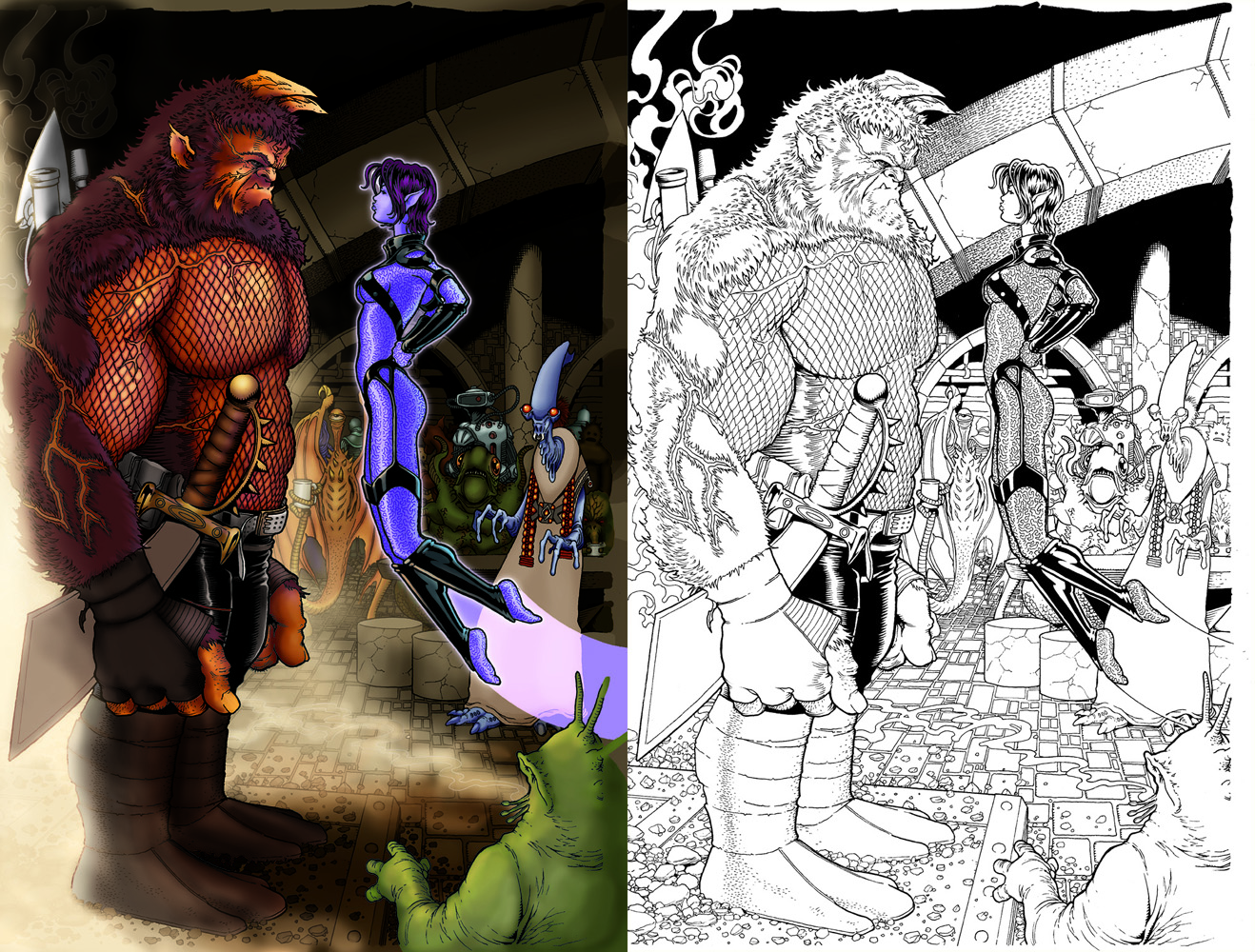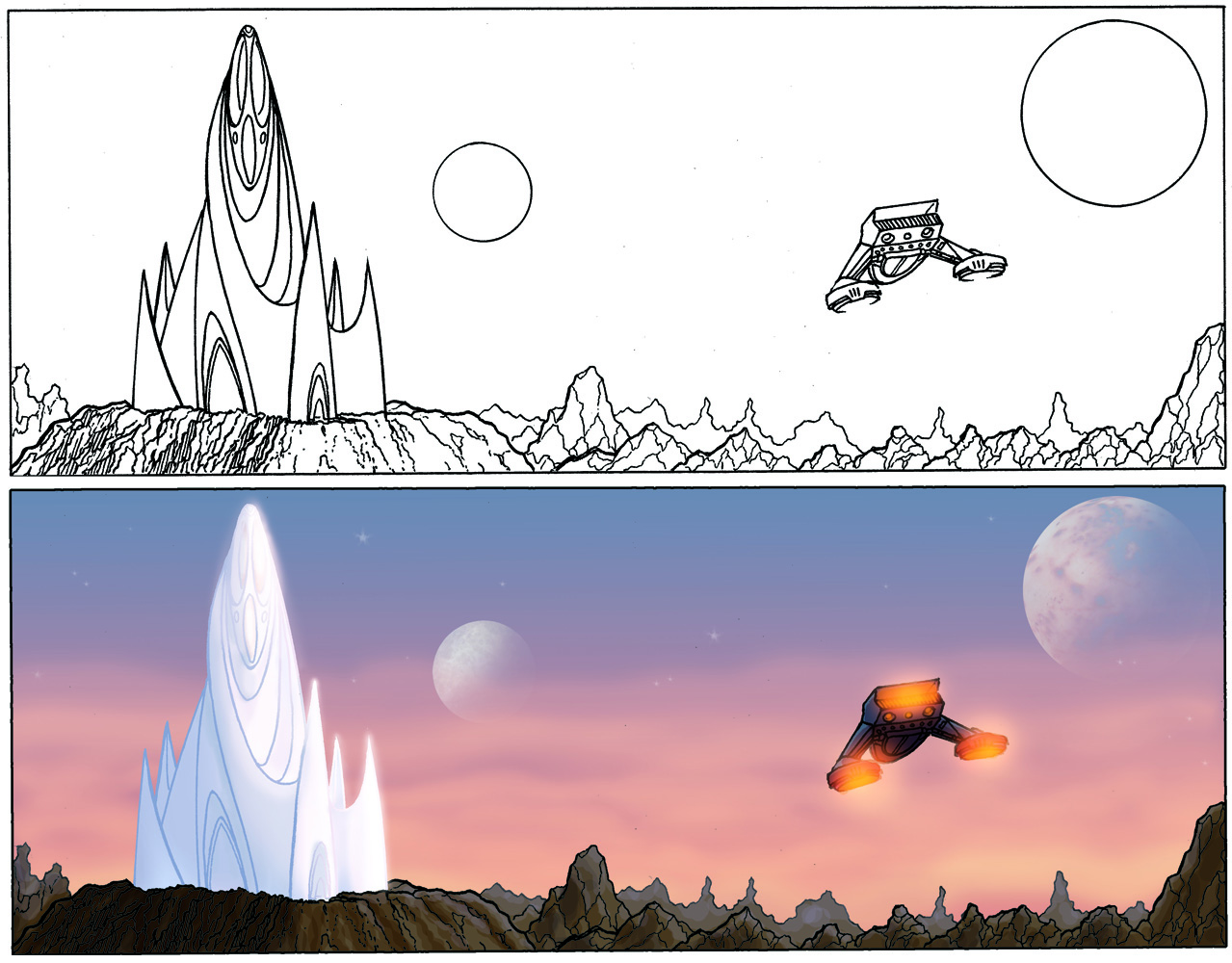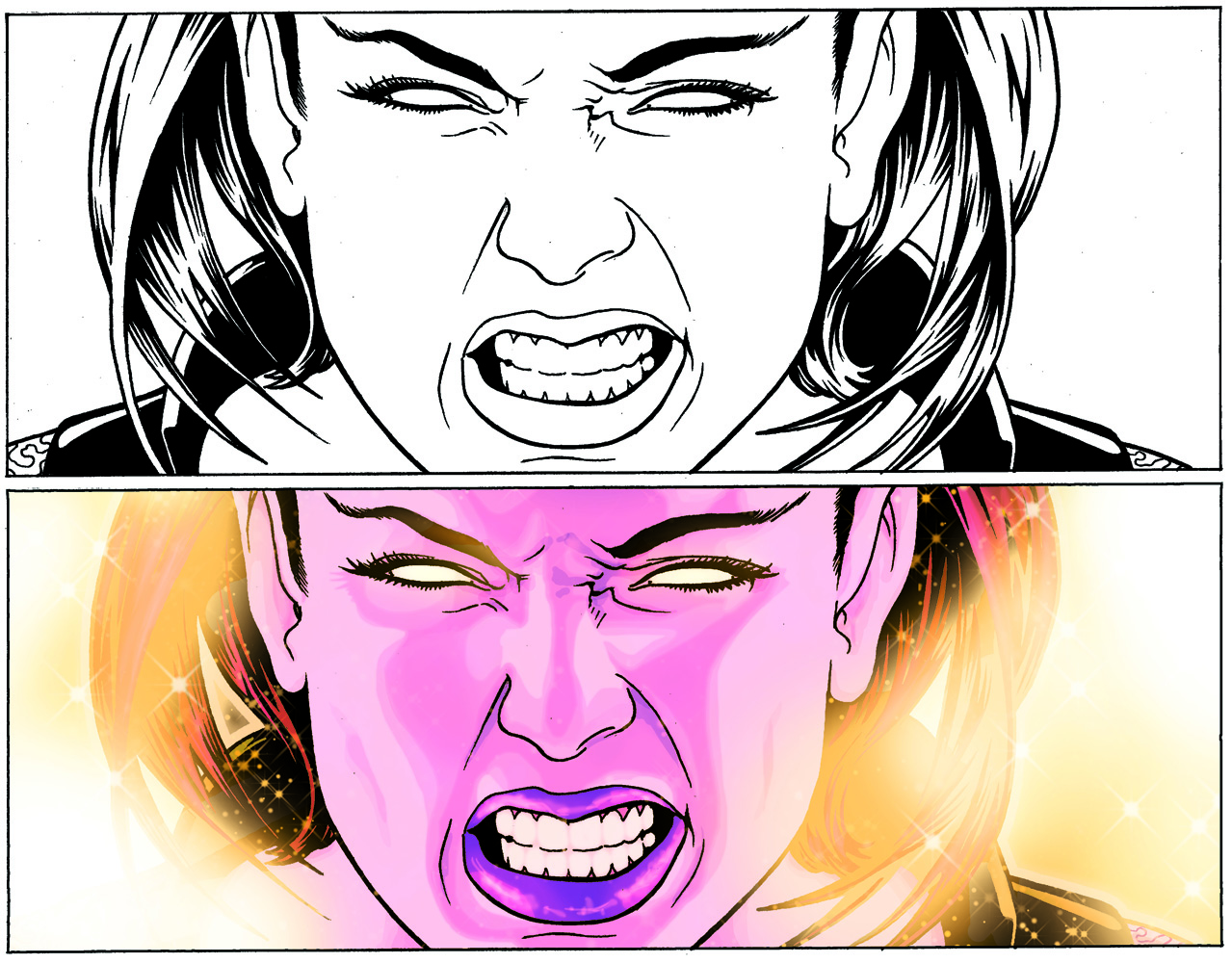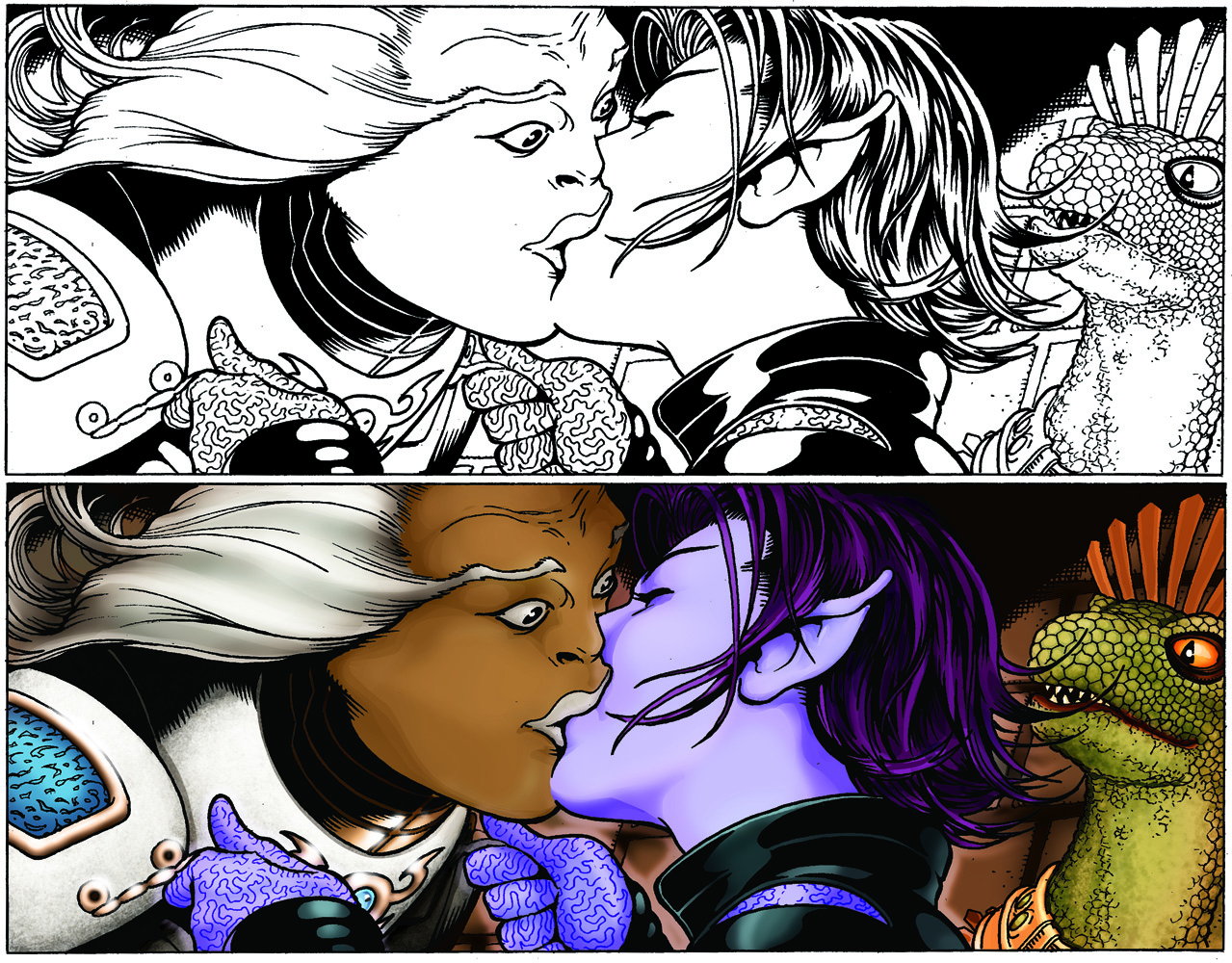 In my line of work (that is, flitting around to various conventions, writing about geeky things, etc), I have had the good fortune to meet a lot of really incredible people in the comic book industry. I've learned a lot through talking with these people, and made fast friends over the years. One of those people is comics colourist Rosemary Cheetham, an up and coming young lady who recently got into colouring and is already impressing professionals and readers alike with her insane attention to detail and her ability to make space scenes pop off the pages.
In my line of work (that is, flitting around to various conventions, writing about geeky things, etc), I have had the good fortune to meet a lot of really incredible people in the comic book industry. I've learned a lot through talking with these people, and made fast friends over the years. One of those people is comics colourist Rosemary Cheetham, an up and coming young lady who recently got into colouring and is already impressing professionals and readers alike with her insane attention to detail and her ability to make space scenes pop off the pages.
Though she's only tackled one major project so far (the DC book Weird Worlds), she is soon going to be working on DC Retroactive: Justice League of America – The 90's. Cheetham did an interview with me about what being a colourist entails, being a woman in the industry, and how to become a colourist yourself.
iFanboy: So, you're a colourist for classic DC artist Kevin Maguire. How did you get into the business?
Rosemary Cheetham: Gosh, I am. It's all a bit of a blur, really. Let's see. I found myself at Emerald City Comic Con almost by mistake. I was visiting a friend in Alaska to fulfil a childhood dream to see the start of the Iditarod and visit the Arctic Circle, and as I live in the UK, to get up there I have to travel through Seattle. I had met and befriended a couple of comic book artists while helping out at a UK comic convention, and when I mentioned my trip I was encouraged to drop in to ECCC on the way home. I was fortunate enough to be sat next to Mr. Maguire as I helped out at my friend's table, and we got talking. It just so happened that it was right at the time that he'd decided he was going to have to get someone else to colour the upcoming Weird Worlds anthology he'd be contributing his creator owned character Tanga to- he'd originally wanted to do absolutely everything himself: writing, pencilling, inking, colouring too. Stars aligned, I told him I knew my way around Photoshop and he told me he'd send me some sample pages. At the time I wasn't sure anything much would come of it. Moral of the story- do mad things. Often.
iF: Did you always want to be a comic book colourist?
RC: Short answer, no. Long answer- I've never really known what career I wanted to end up with, I've just followed my heart, lived in the moment and done things I'm passionate about. I'm a massive astronomy enthusiast, I love physics, I play piano, I restore antique pocketwatches, make my own clothes and jewelry…
I think my next project will be something entirely different. Bricklaying. Who knows.
I have always been a creative person, but beyond the year I worked as a web designer for a Japanese firm in Tokyo, I'd never really considered art or design to be something I could make a career of.
iF: Did you go to art school?
RC: No. I actually studied Japanese at university, including a year at a kind of Japanese finishing school! In college I did an A-level in Graphic Design but I wouldn't really count that- it was just another course alongside the others I was taking and a way to make my timetable on a Tuesday less dense. Our teacher didn't know how to use a projector- I distinctly remember her trying to cover up answers to questions she was putting to the class by putting her hand over them on the wall… and being surprised that the words had jumped onto her skin. Spooky.
 iF: Do you fancy yourself an artist outside of colouring?
iF: Do you fancy yourself an artist outside of colouring?
RC: Not sure. I'm more of a scientist in terms of my core values and interests. I love to know how things work. Perhaps a better word for what I think I am would be 'enthusiast'.
iF: Have you always been into comic books?
RC: Can't say I have. I only started reading comic books around the time Adi Granov was drawing covers for Iron Man: Director of S.H.I.E.L.D., which was when I first had the urge to buy one. I was hooked by Warren Ellis's Extremis, reading Iron Man single issues from then on in, and eating up anything my comic book friends would lend me. Growing up I was always more of a sci-fi girl, addicted to Star Trek and just about any space-themed TV show I could glue myself to. Anyone else remember Earth: Final Conflict? I loved that show. It wasn't just TV- I read anything I could find by Asimov, Clarke, Wells, Wyndham etc… so I suppose if I'd been introduced to sci-fi comics at any point in my childhood I would have become a fan of the medium pretty quickly too.
iF: What are your favourite comic books right now?
RC: Currently- well, Weird Worlds, the one I've just wrapped up, is pretty good! Strong, personable, purple alien woman and her adventures in space, what's not to love? Paul Cornell and Pete Woods' run on Action Comics is great and I'm massively enjoying just about anything they let Kieron Gillen get his hands on. I tend to buy comic books at the moment for the story first and the art second, which I guess is a little odd for a colourist. I've also got decades of books to catch up on, so some of my favourites aren't new ones! Planetary is fantastic, especially from a colouring point of view. I adore Captain Britain and mourn the cancellation of the title any time I think of it.
iF: What is your favourite colouring job?
RC: I wish I could show you my absolute favourite, but you'll have to wait for Weird Worlds #6 to come out! Suffice it to say I have had a lot of fun with bringing Kevin's monsters into life, and that I love sunset colours. Page one of issue six- that's my favourite. The last page isn't bad either. In general the panels I am pleased with the most are ones where I get to create the mood of a whole landscape.
As I can't share my absolute favourite I think I'd have to say this full page spread of Korghan's entrance from issue 2, though I think I'd do it a little differently now. That's the curse of perfectionism I guess!
iF: What are your aspirations for the future?
RC: Not entirely sure. Colouring-wise, I'd love to diversify a bit while improving, learning, and keeping on working with Kevin. He's got the most incredible linework and such a cinematic sense of composition when it comes to his story telling, and I get the most incredible buzz seeing the latest masterpiece turn up in my inbox. I can't wait to finish our Tanga story- Weird Worlds is only half of the whole thing. Though honestly, if I get one more page filled with ridiculously detailed teeny tiny bits of debris or floating space rocks, we may actually come to blows.
Long term, I'd love to write, maybe for a sci-fi anthology. In the realms of the ridiculous, I'd do almost anything for the chance to experience spaceflight- though to be entirely honest I aspire simply to be someone people would rather see coming than going. Anything else is a wonderful bonus. Oh, and to be filthy rich and able to buy all the shoes. That'd be great.
iF: What's your dream comic to work on?
RC: Iron Man. I have the hugest crush on Tony Stark, it's not even funny.
iF: Do you have anything to say about being a woman in the industry?
RC: Too much for this interview, I'd say. I'm definitely not the only woman who finds it very easy to get frustrated by the common misconceptions that seem to follow anyone with breasts who gets into a male-dominated profession. Here's an example: two guys meet in a bar at a con and decide to work on a project together, that's normal. A guy and a girl do the same thing, and some ignorant people start raising eyebrows. I've heard it's much better now than it used to be, which is encouraging, and now there are more of us around it'll get easier and easier. I guess I'd say, let your work speak for you.
 iF: Any advice on putting together a portfolio?
iF: Any advice on putting together a portfolio?
RC: Hm. I don't actually have one. A lot of editors I've spoken to have said they would send me some linework for me to try out on and take it from there. I guess I'd advise having a digital portfolio that you can link people to. I put samples of my work up on my Facebook page.
iF: Any advice on networking?
RC: Yes, plenty. Do it. There! I have a terrible memory, so I tend to scribble notes on people's business cards so they won't just be pieces of paper with names I can't attach to faces later on. Simple things, like a reminder of what we talked about, or where we met. Beyond that, I'd say it's just like any other kind of social situation really. Just be yourself, but at your best. Polite, friendly and relaxed.
iF: What was the hardest thing about becoming a colourist?
RC: I think it was the point where I had to admit to myself this was something that I really, genuinely wanted. Wanting something is a risk, because it opens you up to the possibility of losing it. After that, it was the long weeks of samples being sent to DC editors and the will-they-won't-they nailbiting purgatory I'd effectively committed to shuffling around in until I was given a definitive yes or no. Kevin was an absolute rock through all of that. We became very firm friends and he had to talk me down from so many concession speeches when I still hadn't heard back and was basically giving it up for a lost cause. I probably would have thrown in the towel if it weren't for his encouragement.
iF: What should people keep in mind if they are going to pursue the same line of work as you?
RC: The good thing about freelance colouring- or I suppose any kind of comic book work- is that you can work from anywhere in the world as long as you have an internet connection and a way for them to pay you. You can travel! The flipside is, you will end up working everywhere you go. You may end up surgically attached to your graphics tablet. Just like any kind of working from home job you will need a lot of self discipline. I think I lost mine somewhere between Facebook, Spaceflight Now and Twitter, but I'm working on it.
 iF: What tools do you work with?
iF: What tools do you work with?
RC: I use a Wacom graphics tablet and Photoshop CS5 on my shiny new Dell laptop. I worked on a second-hand Macbook pro before, but when it died I decided I could get more memory for my money by abandoning Apple. I didn't shed many tears, and getting a super-fast processor and oodles of RAM means my .psd files save in a flash. Lovely. I'm in between apartments, but once I'm more settled I'll be investing in a nice big monitor, too. A quick note- it is so important to have a properly calibrated monitor no matter what set-up you have- things will always look different on the page but you want to be pleasantly surprised, not horrified.
iF: How much creative control do you have to give up?
RC: Depends on the job and your editor. I'm going to be following Kevin onto his next project, the 90s Justice League issue of Retroactive- and of course that carries with it a lot more restrictions on colours and so on. For Tanga, Kevin's always given me a pretty free rein and allowed me to really build on his lines, which is one of the reasons I enjoy working with him.
iF: Do you have any advice for people who want to break into the industry?
RC: I'm not sure I've been in it long enough to give advice. I suppose I'd just say the same thing I'd say to anyone who has a dream. Make it happen. It's not enough to hope to get lucky. Seize every single opportunity and use it to the best of your ability- because in the end you only really end up regretting things you didn't do.
Thank you, Rosemary, for agreeing to do this interview. I hope you readers found it enlightening and were able to gather some useful information from it.
Molly McIsaac hates it when people tell her unicorns don't exist and could probably make furniture out of her huge stacks of comic books. Follow her adventures on twitter.


I’m kind of interested in getting into coloring as a hobby, what classes should I take?
Cool process interview!
I’d love to see more features on iFanboy about the production process after penciling, specifically lettering and graphic design and how and why people makes the choices they do for certain issues. In something like Uncanny X-Force, or Hulk/Atlas the colorist is as important as the penciler in establishing the tone and look of the series.
(I also meant to say “Cool article!” at the top.)